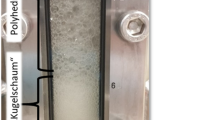Summary
Exocellular fibrils, consisting of true cellulose, were found to be produced by many bacteria. These bacteria have been selected out of a large number of strains isolated from activated sludge on the basis of their flocculent growth habit in liquid medium.
The amount of cellulose, present in the bacterial flocs, varied from 1.0 to 4.0%. In addition to strains isolated from activated sludge, like Pseudomonas, Achromobacter, Alcaligenes and Aerobacter, also strains of the genera Rhizobium, Agrobacterium and Azotobacter were found to give flocculent growth due to the formation of cellulose fibrils.
Bacterial flocculation in pure cultures of the strains examined was mainly caused by the production of exocellular fibrils. Apparently, the formation of cellulose fibrils seems to be a common property of Gram-negative, floc-forming bacteria, and may not be restricted to Acetobacter xylinum.
Similar content being viewed by others
References
Angelbeck, D. I., Kirsch, E. J.: Influence of pH and metal cations on aggregated growth of non-slime forming strains of Zoogloea ramigera. Appl. Microbiol. 7, 435–440 (1969).
Barker, S. A., Bourne, E. J., Whiffen, D. H.: Use of infrared analysis in the determination of carbohydrate structure. Meth. biochem. Anal. 3, 213–245 (1956).
Bloch, M.: Beitrag zur Untersuchung über die Zoogloea ramigera (Itzigsohn) auf Grund von Reinkulturen. Zbl. Bakt., II. Abt. 48, 44–62 (1918).
Butterfield, C. T.: Studies on sewage purification. II. A zoogloea-forming bacterium isolated from activated sludge. Public Health Rep. U.S.A. 50, 671–684 (1935).
Canale-Parola, E., Borasky, R., Wolfe, R. S.: Studies on Sarcina ventriculi. Localization of cellulose. J. Bact. 81, 311–318 (1961).
Crabtree, K., Boyle, W., McCoy, E., Rohlich, G. A.: A mechanism of floc formation by Zoogloea ramigera. J. Water Pollut. Contr. Fed. 38, 1968–1980 (1966).
—, McCoy, E., Boyle, W., Rohlich, G. A.: Isolation, identification and metabolic role of the sudanophilic granules of Zoogloea ramigera. Appl. Microbiol. 13, 218–226 (1965).
Dugan, P. R., Lundgren, D. G.: Isolation of the floc forming organism Zoogloea ramigera and its culture in complex and synthetic media. Appl. Microbiol. 8, 357–361 (1960).
Friedman, B. A., Dugan, P. R.: Identification of Zoogloea species and the relationship to zoogloeal matrix and floc formation. J. Bact. 95, 1903–1909 (1968).
——, Pfister, R. M., Remsen, C. C.: Fine structure and composition of the zoogloeal matrix surrounding Zoogloea ramigera. J. Bact. 96, 2144–2153 (1968).
————: Structure of exocellular polymers and their relationship to bacterial flocculation. J. Bact. 98, 1328–1334 (1969).
Heukelekian, H.: Carbon and nitrogen transformations in the purification of sewage by the activated sludge process. II. Morphological and biochemical studies of zoogloeal organisms. Sewage Works J. 11, 752–763 (1939).
Holt, S. C.: The comparative ultrastructure of Sarcina maxima and Sarcina ventriculi. Antonie v. Leeuwenhoek 32, 451 (1966).
Jayme, G., Lang, F.: Cellulose solvents. Meth. Carb. Chem. 3, 75–83 (1963).
McKinney, R. E., Weichlein, R. G.: Isolation of floc-producing bacteria from activated sludge. Appl. Microbiol. 1, 259–261 (1953).
Mühlethaler, K.: The structure of bacterial cellulose. Biochim. biophys. Acta (Amst.) 3, 527–535 (1949).
Schmidt-Lorenz, W.: Methoden zur quantitativen Isolierung und Bestimmung von in Lebensmitteln vorkommenden Bakterien. In: Anreicherungskultur und Mutantenauslese. Symposium Göttingen, S. 270–325. Stuttgart: Fischer 1965.
Somogyi, M.: Notes on sugar determination. J. biol. Chem. 195, 19–23 (1952).
Stockdale, H., Ribbons, D. W., Dawes, E. A.: Occurrence of poly-β-hydroxybutyrate in the Azotobacteriaceae. J. Bact. 95, 1798–1803 (1968).
Tezuka, Y.: Magnesium ion as a factor governing bacterial flocculation. Appl. Microbiol. 15, 1256 (1967).
—: Cation-dependent flocculation in a Flavobacterium species predominant in activated sludge. Appl. Microbiol. 17, 222–226 (1969).
Trevelyan, W. C., Harrison, J. S.: Studies on yeast metabolism. I. Fractionation and microdetermination of cell carbohydrates. Biochem. J. 50, 298–310 (1952).
Unz, R. F., Dondero, N. C.: The predominant bacteria in natural zoogloeal colonies. Canad. J. Microbiol. 13, 1671–1682 (1967).
Van Gils, H. W.: Bacteriology of activated sludge. Res. Inst. Public Health Eng. IG-TNO Rept. No 32. The Hague, Holland 1964.
Author information
Authors and Affiliations
Rights and permissions
About this article
Cite this article
Deinema, M.H., Zevenhuizen, L.P.T.M. Formation of cellulose fibrils by gram-negative bacteria and their role in bacterial flocculation. Archiv. Mikrobiol. 78, 42–57 (1971). https://doi.org/10.1007/BF00409087
Received:
Issue Date:
DOI: https://doi.org/10.1007/BF00409087




